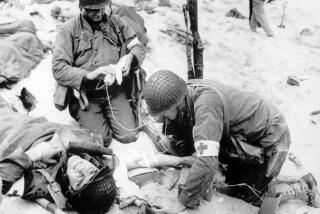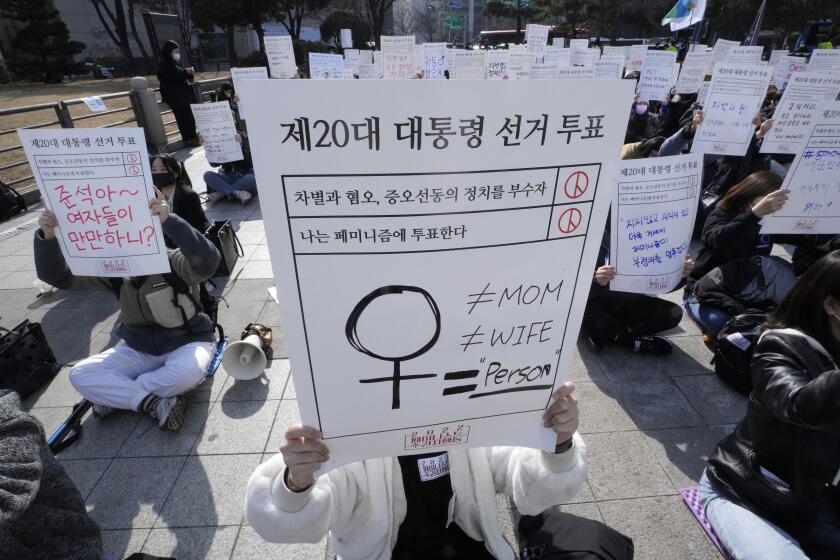Lucile Petry Leone; Led U.S. Cadet Nurse Corps
- Share via
Being “The Girl With the Future” the advertisement in the summer of 1943 declared, meant joining the U.S. Cadet Nurse Corps, the first federally funded professional education program designed for women.
Lucile Petry Leone played a large part in shaping that future for thousands of women.
Leone, who died Nov. 25 at an assisted living facility in San Francisco at the age of 97, headed the civilian corps, which was so successful that no nurses had to be conscripted for duty during World War II. Largely through her efforts, the corps changed the way Americans viewed nursing, bringing legitimacy to a profession that before the war was considered something “a lady would not do.”
Information from the Nursing Archive Collection at Boston University and from the University of Wisconsin School of Nursing offers a clear picture of Leone’s career and the state of the nursing profession during the war.
Assistance for the ill and infirm was becoming a major domestic issue by mid-1943. At least 20% of America’s nurses and many of its eligible doctors had joined the military.
Overcrowded hospitals were turning away patients. Overworked civilian doctors had little time to do what was then routine: call on patients in their homes. Nurses were in short supply, too, so there were fewer of them to provide home care.
In a visit to Los Angeles in August 1943, Dr. Thomas Parron, the U.S. surgeon general, called the civilian medical problem acute, and said that because of the shortage of nurses, “nursing care is at a danger level in many communities.”
To counter the crisis, Congress passed the Bolton Act in 1943 to shore up civilian medical care. The measure created the Cadet Nurse Corps.
From July 1943 to October 1945, about 132,000 women were admitted to colleges across the country under the act. In exchange for federal funding, participating colleges were required to establish a 24- to 30-month accelerated eduction program for nurse candidates. And the women who enrolled had to pledge to “engage in essential nursing, military or civilian, for the duration of the war.”
In return for that pledge, the government paid all tuition fees and a monthly stipend that ranged from $15 to $30, depending on the seniority of the nurse candidate, and supplied distinctive uniforms by fashion designer Molly Parnis.
Working through the Office of War Information, a massive recruitment campaign was begun. The ad campaign, created by the J. Walter Thompson agency, offered such slogans as: “The Girl With the Future” and “Enlist in a Proud Profession.”
The country was blanketed with posters on buses, streetcars and billboards. In Los Angeles, streetcar passes carried pictures of nurse corps cadets and recruitment slogans. There was generous newspaper publicity, including editorials and feature stories.
The daughter of a school administrator from Lewisburg, Ohio, Leone graduated with honors from the University of Delaware with a double major in chemistry and English in 1924. She earned a nursing degree from the Johns Hopkins School of Nursing, where she later specialized in psychiatric nursing. She also attended Teachers College at Columbia University, where she received a master’s degree.
Her progress toward a PhD at Columbia ground to a halt in 1941, when she was appointed to an administrative post with the U.S. Public Health Service. She was the first woman to hold such a position. In May 1943, after two years as senior public health nursing consultant, she was appointed the first dean of the Cornell University-New York Hospital School of Nursing in New York City. One month later she was given a year’s leave to take charge of the Cadet Nursing Corps. She never returned to Cornell.
The Cadet Corps administrator, charged with the training of “the first group of women ever to receive free professional educations,” launched her recruiting campaign immediately.
She sent telegrams to 1,294 nursing schools--not, she emphasized, as a dramatic gesture--”but because new classes were forming and it was imperative that both students and schools be able to make their plans.”
In the fall of 1943, 5 million mailings of dependency checks to servicemen’s families carried inserts about the corps.
From the outset, Petry was a persuasive saleswoman in explaining the financial benefits of the Bolton Act.
“Girls have their pick of patriotic duties, most of which offer immediate recognition or pay,” she said. “By contrast the student nurse formerly had 36 months of hard training at her own expense.”
Recruitment became competitive. Streetcar cards in Los Angeles had signs that proclaimed: “Only 5,416 more opportunities to enlist this month. Join the Cadet Nurse Corps.”
Applicants had to be between 18 and 35, graduates of accredited high schools with good scholastic records and good health.
Hospitals such as Good Samaritan, Queen of Angels and St. Vincent’s in Los Angeles and Huntington Memorial in Pasadena became recruitment and training centers and in the process helped set up a new relationship between institution and nurse that would become the norm after the war.
Before the war, nurses were independent contractors working for hospitals through registries. After the Cadet Nurse Corps, hospitals, eager to retain the women they had trained, offered them staff positions.
McVey, the president of the California Nurses Assn., said nurse training was more uniform during the war.
Leone kept up the recruitment campaign right to the end. Although the war in Europe was over, she was still sending out personal letters in July 1945, offering information about the corps to the 25,000 selected applicants.
The corps was disbanded in October 1945, two months after the Japanese surrender. Students who had enrolled three months before the end of the war were allowed to continue their education. The last students graduated in June 1948. The total federal bill for the program was more than $160 million.
Leone, described in press accounts at the time as short and slim with a youthful appearance despite her gray hair, benefited from the Nurse Corps as well.
In 1949 she was promoted to the rank of an assistant surgeon general in the Public Health Service Commissioned Corps and to the position of chief nurse officer, guiding the work of 2,500 nurses in the Public Health Service. She held that position until her retirement in 1966. She was a delegate to the first assembly of the World Health Organization in 1948 and the ninth assembly in 1956.
In 1959 she was awarded the Florence Nightingale Medal by the International Committee of the Red Cross and in 1965 she received the Distinguished Service Award of the Public Health Service.
Leone was married to Dr. Nicholas C. Leone, a physician with the U.S. Public Health Service.
After her retirement, the agency established the Lucile Petry Leone Award to recognize outstanding contributions in the area of nursing education.
The Leones moved to Texas, where she taught nursing at Texas Women’s University. She retired from that post in 1971.
She had no immediate survivors.
More to Read
Sign up for Essential California
The most important California stories and recommendations in your inbox every morning.
You may occasionally receive promotional content from the Los Angeles Times.













